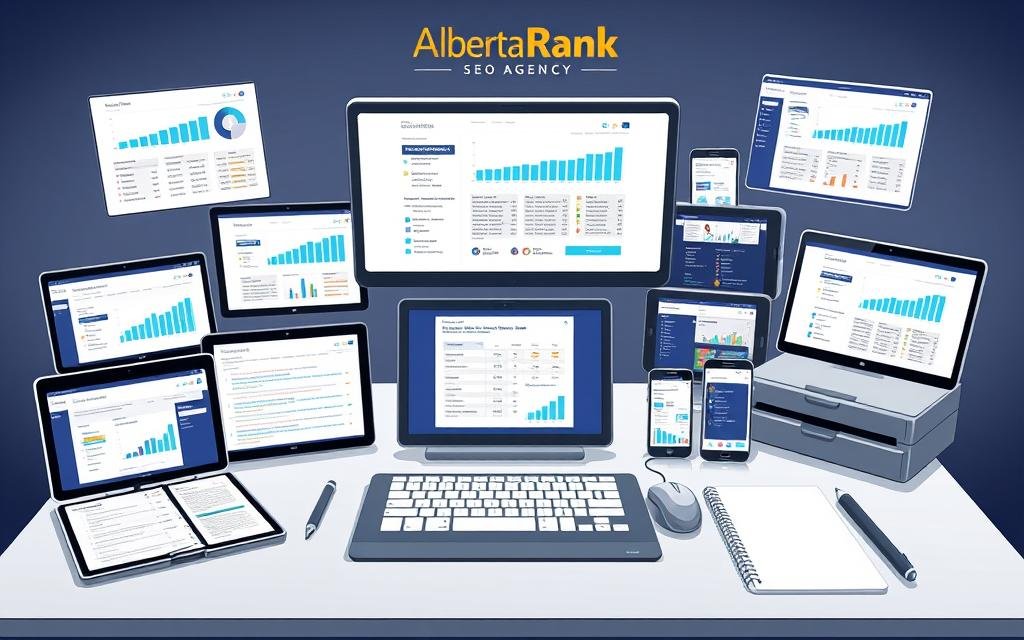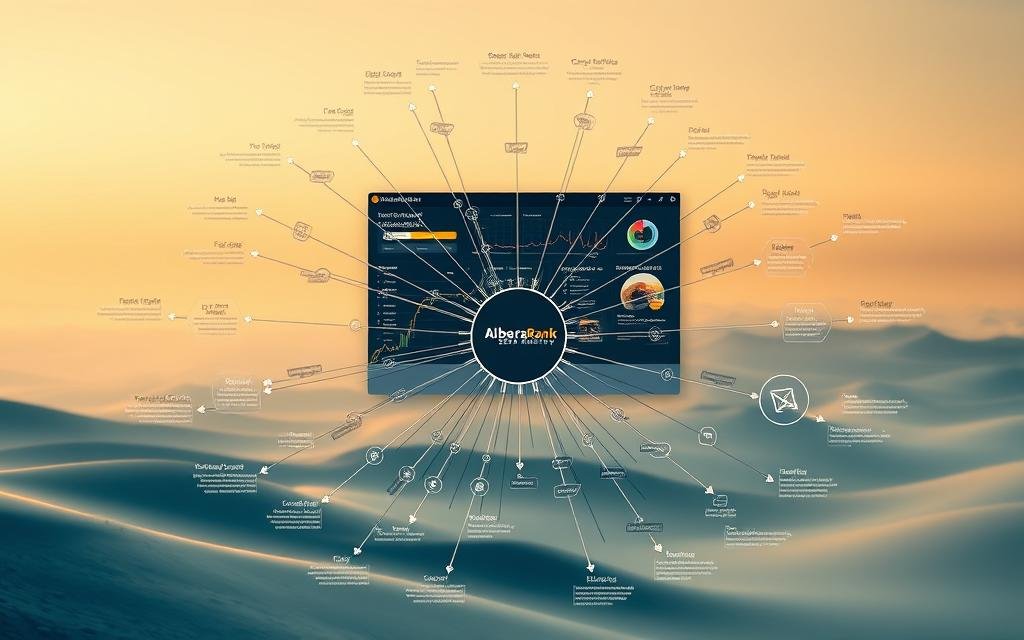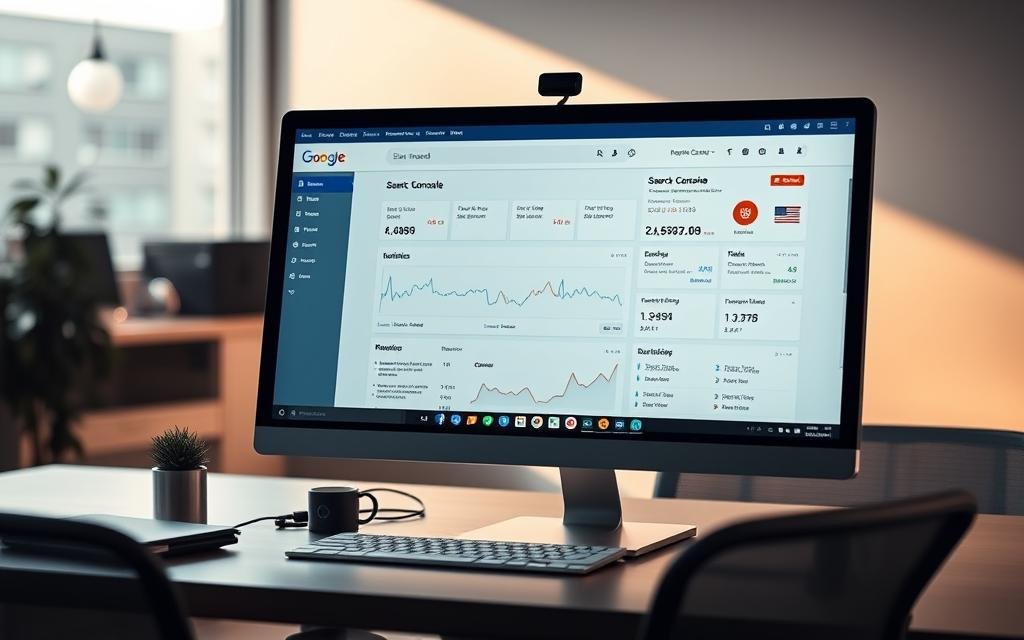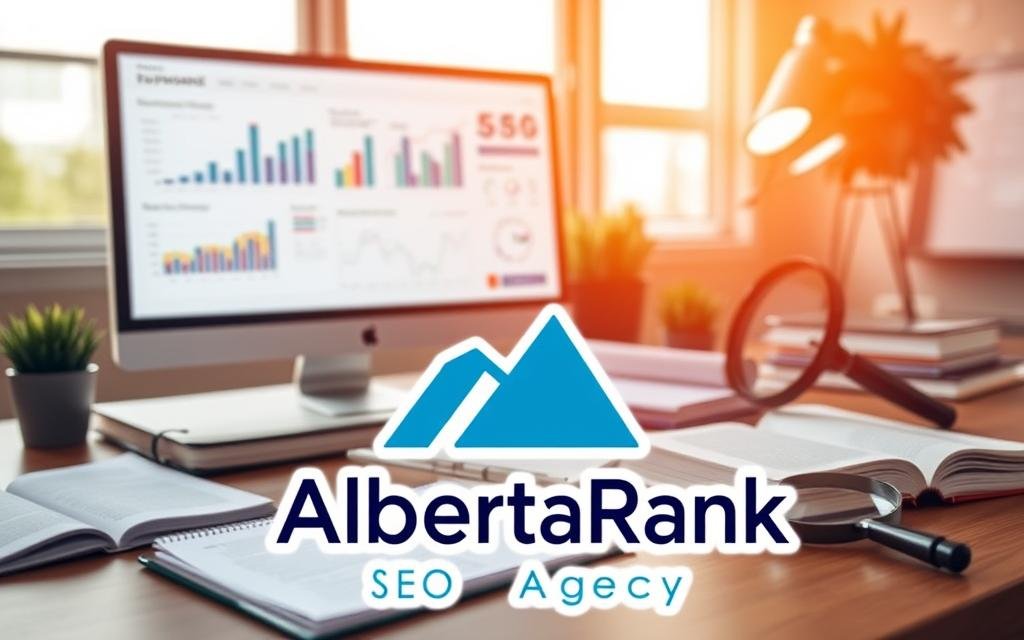Can one smart search plan turn local clicks into real sales for a Calgary or Edmonton business?
We know Alberta small businesses need practical SEO that moves the needle. At AlbertaRank, we focus on the right terms that match buyer intent and lead to calls, bookings, and sales — not just vanity traffic.
AI overviews, TikTok discovery and changing search habits mean your content must map intent to revenue in 2025. We use a local-first approach that prioritizes “near me” and province-specific terms so your pages show up when Albertans are ready to buy.
This guide previews tool comparisons and clear tactics. We show how to translate data into action: content briefs, topic clusters, internal links and on-page fixes that boost both rankings and conversions.
Get focused, avoid wasted effort, and build a stack that fits your budget. Contact us during business hours for a quick, no‑fluff chat about improving local performance.
Key Takeaways
- Local-first tactics turn searches into measurable leads for Alberta businesses.
- Prioritise commercial intent and province-specific terms to drive revenue.
- We map tool data to content and PPC actions that boost conversions.
- Avoid broad topics that attract clicks but not customers.
- Contact AlbertaRank for a concise, results‑driven strategy tailored to Calgary and Edmonton.
Why keyword research matters now: 2025 search realities for Canadian businesses
With AI summaries and social discovery rising, local businesses need a sharper plan to capture clicks that convert.
HubSpot data shows 31% of users start on social media, 12% on AI chat, and 88% still use Google. That mix changes what terms are valuable. AI Overviews often answer basic questions on the SERP, which reduces clicks for purely informational queries.
We recommend prioritising transactional and commercial‑investigation terms that still earn clicks. Use owned data (GA4, GSC) to see where Calgarians or Edmontonians actually search, then expand with broader signals to avoid blind spots.
Audience discovery is fragmented: people find ideas on TikTok or YouTube and then validate on Google. Your strategy must map queries to each surface and weigh click potential, not just volume.
- Balance high‑intent phrases with mid‑funnel topics for education and retargeting.
- Include SERP feature analysis to spot zero‑click risks.
We focus on practical plans that turn local searches into qualified leads, not vanity metrics.
Commercial intent decoded: aligning keyword research with revenue and ROI
Start with terms that show clear buyer intent — those are the pages that pay the bills.
We define three intents that matter for Alberta retailers and services: commercial (comparison or product pages), transactional (buy, book, order), and navigation (branded or local). Each maps to a different revenue lift.
Identify bottom-funnel keywords your site can rank for by balancing difficulty with local authority. Prioritise pages that capture leads or sales now — product lists, service pages, and booking forms.
Quick qualifying framework:
- Check search intent and clickability in a SERP with AI elements.
- Spot monetisation signals: shopping results, local packs, strong commercial snippets.
- Match the phrase to your revenue model and conversion path.
Translate PPC data to organic opportunities. Use GA4 and GSC to tie a page and phrase to leads and revenue. That keeps budgets focused and shows real ROI for Calgary and Edmonton businesses.
What makes a great keyword research tool in 2025
Picking the right tool changes hours of guesswork into clear, actionable work for Calgary and Edmonton teams. We look for platforms that combine reliable metrics with workflow helpers so small teams publish faster and smarter.
Must‑have data: search volume, difficulty, SERP/feature analysis
Essential metrics include search volume, keyword difficulty and a competitive SERP snapshot. These tell you where clicks still exist and which pages to prioritise.
SERP feature analysis—featured snippets, local packs, shopping and image packs—is critical in 2025. AI layouts change click behaviour, so spotting zero‑click risks saves time.
Free plan limits vs. real usability and upgrade paths
Free tiers give a taste but often block real workflows. Semrush caps reports and tracked terms, KWFinder and Ubersuggest limit daily searches, while Google Keyword Planner stays useful for paid forecasting.
Our advice: start with a free core, then add one paid option when you need rank tracking or deeper organic insights.
Standalone functionality and workflow efficiency
Great seo tools do more than list phrases. Look for clustering, intent tagging and brief generation so you can ideate, qualify and brief without switching apps.
- Integration matters: connect to GA/GSC for Organic Traffic Insights.
- Efficiency features speed publishing for lean teams.
- Choose a stack that balances cost with the data you actually use.
Keyword Research tools at a glance: free, affordable, and pro options
For local teams, one pro platform and one light ideation app covers most needs without breaking the bank.
We group tools by use case so you can pick fast: paid planning, deep SEO, ad hoc lookups, content ideation and competitive intel. Below is a quick overview of free picks and limits to plan your week.

Quick categories and suggested picks
- Paid keywords / forecasting: Google Keyword Planner — free for paid keyword forecasts and monthly search estimates.
- Deep SEO: Semrush — advanced features; free plan allows about 10 analytics reports/day.
- Ad hoc lookups: KWFinder — useful for quick checks (≈5 searches/day on free tier).
- Content ideas: Ubersuggest — geared to content marketing (≈3 searches/day free).
- Competitive intel: Ahrefs, SpyFu, Serpstat — best when backlink and competitor depth matter.
| Tool | Best for | Free limits | Affordable upgrade benefit |
|---|---|---|---|
| Google Keyword Planner | Paid planning & forecasts | Free access with Ads account | Monthly search and budget forecasts |
| Semrush | All‑round SEO tools & workflows | ≈10 analytics reports/day | Tracking, briefs, gap analysis |
| KWFinder | Ad hoc lookup & intent signals | ≈5 searches/day | More queries and SERP details |
| Ubersuggest | Content idea generation | ≈3 searches/day | Content plans and more ideas |
| LowFruits / WPBeginner tools | Long‑tail ideation & zero-login ideas | Free/basic access | Long‑tail clusters and fast wins |
Our tip: mix one pro platform (Semrush or Ahrefs) with a free ideation tool (AnswerThePublic or the WPBeginner generator). That combo gives depth and speed for Calgary and Edmonton teams while keeping costs sensible.
Google Keyword Planner: the gold standard for paid keywords (and helpful organic clues)
Before you build pages, let ad forecasts show which queries actually drive purchases in Calgary and Edmonton. We use Google Keyword Planner to test ideas fast and learn value from live ad signals.
What it gives you: the Planner is completely free and delivers keyword ideas with monthly search volume, competition levels, ad impression share and bid ranges. It also pulls suggestions from your website and includes a Forecast tool for budget planning.
Forecasting, budget planning, and website‑based ideas
Use the Forecasts to estimate clicks and costs before you run campaigns. That helps set realistic monthly search volume targets and ad budgets for Calgary or Edmonton markets.
How to turn PPC data into organic opportunities
- Export keyword ideas with search volume and bids.
- Tag phrases by intent and separate brand vs non‑brand terms.
- Build a page plan: priority service pages first, supporting posts next.
Practical tip: If a phrase converts in Ads, plan an SEO page to capture that demand organically over time. Interpret competition and bid ranges as a proxy for commercial value and likely organic difficulty.
| Feature | Value for Alberta SMBs | How we use it |
|---|---|---|
| Monthly search volume | Shows local demand | Prioritise pages by real search counts |
| Bid ranges & Forecast | Estimates ad cost and conversion potential | Set budgets and test high‑value terms |
| Website suggestions | Uncovers content gaps | Turn gaps into briefs and pages |
| Brand vs non‑brand filters | Prevents skewed projections | Expand reach beyond your name terms |
Semrush: granular data and advanced workflows for serious SEO
When you need advanced workflows and precise ranking signals, Semrush is the platform we turn to. We use it to move local pages from visibility to conversions for Calgary and Edmonton businesses.
Core tools we rely on: the Keyword Overview, Keyword Magic Tool and Keyword Manager speed discovery and filtering by intent, search volume and keyword difficulty. Position tracking and Keyword Gap reveal missed opportunities. Cannibalization reports tidy overlapping pages so rankings stabilise.
How we use the data
- Expand themes with the Magic Tool and filter by intent and difficulty to prioritise commercial phrases.
- Run Gap analysis to find terms competitors rank for but you don’t, then plan net‑new pages tailored to Alberta niches.
- Use Organic Traffic Insights (via GA/GSC) to surface “not provided” queries and match them to landing pages for optimisation.
- Leverage SERP feature data to target featured snippets and other elements that lift CTR in competitive results.
Free tier vs when to upgrade
The free plan gives about 10 analytics reports per day and 10 tracked keywords — fine for light work or a quick audit. For ongoing tracking, briefs, and large content programmes, the paid tiers justify the cost.
“We recommend starting small: validate a few high-value terms, then scale tracking and briefs when you see wins.”
| Feature | Value for Alberta SMBs | When to upgrade |
|---|---|---|
| Keyword Magic & Manager | Fast theme expansion and filtering by intent | Need many lists or team briefs |
| Position Tracking | Local ranking signals for Calgary/Edmonton | Multiple locations or many pages to track |
| Keyword Gap | Find competitor opportunities | Launching a content programme |
| Cannibalization report | Consolidate pages and improve ranking stability | Site has many similar service pages |
| Organic Traffic Insights | Recover “not provided” queries and map to pages | Need conversion-linked keyword data |
KWFinder: high‑value ad hoc research with intent and opportunity signals
For ad‑hoc checks that save time and cut through noise, we use KWFinder as a compact, action‑first tool. It gives clear data you can use in minutes for Calgary and Edmonton pages.
What it shows: the free plan allows five searches per day and returns search volume, keyword difficulty, related terms, a SERP breakdown and intent tags. It also flags “keyword opportunities” — gaps like outdated top results or missing full phrases in meta titles.
How we use it:
- Run quick lookups to validate if a query needs a transactional page or an educational post.
- Scan the opportunities column to spot weak titles or stale articles you can outrank.
- Turn findings into on‑page fixes or compact briefs for a writer or dev team.
KWFinder’s five‑search limit fits weekly sprints or rapid validation. For scaling lists and tracking, we pair it with a larger suite. Use KWFinder when you need solid signals fast and a short path from discovery to content updates.
Ubersuggest: content ideas, comparison keywords, and affordable scaling
For content teams on a budget, Ubersuggest packs practical signals into a simple, usable dashboard we can action in hours. The free plan allows three searches per day and returns a Keyword Overview with monthly search and clear SEO/paid difficulty metrics.

Content Ideas lists ranking pages and shows visits, other keywords they rank for, backlinks and social metrics. We use those signals to pick topics that perform across channels and lift local marketing efforts in Calgary and Edmonton.
Turning overviews into briefs
We turn Content Ideas into short, prioritised briefs: title, two H2s, and target links. This creates a fast path from idea to publish without a big agency budget.
- Use comparison phrases (vs, alternatives) to capture buyers near purchase.
- Choose topics with strong social signals to repurpose on TikTok or Facebook.
- Batch three free searches, then upgrade when you need daily volume or tracking.
“Affordable upgrades add rank tracking and daily volume — useful when you scale content programmes.”
LowFruits: uncovering low‑competition long‑tails you can actually rank for
LowFruits uncovers long‑tail openings that smaller Alberta sites can win fast.
How it helps: LowFruits mines Google autocomplete to surface intent‑rich phrases people actually type. It then analyses the top 10 SERPs to spot low‑authority domains and realistic ranking opportunities.
We use LowFruits to build early momentum. The tool clusters related terms by intent or semantics, flags weak SERPs, and adds rank tracking and domain exploration so we can measure movement.
- Pick winnable long‑tails to accelerate results for Calgary and Edmonton sites.
- Use autocomplete mining to capture customer phrasing and local searches.
- Detect SERP weakness where small sites already rank — those are low‑effort wins.
- Cluster terms to design pillar and supporting pages and avoid cannibalisation.
- Move clusters straight into briefs and drafts to keep publishing cadence high.
Practical tip: Combine LowFruits ideas with on‑page edits and local landing pages. That mix lowers keyword difficulty and produces measurable results faster than broad topic chasing.
Ahrefs, Serpstat, SpyFu: when competitive depth and backlink intelligence matter
When your niche is crowded, link and competitive data decide who climbs the local SERPs.
We use Ahrefs when backlink depth and an expansive index matter. Its link graphs and reliable difficulty scores help us spot domains we can realistically outrank.
Serpstat sits between power and price. It offers keyword data, CPC trends and SERP snapshots, including the featured snippet holder. That makes it a strong value pick for small teams.
SpyFu shines for competitor PPC and historical SEO insights. You can see paid terms rivals bid on and then target those phrases organically with focused pages.
How to choose for Calgary and Edmonton
- Pick Ahrefs if backlink intelligence will decide your strategy.
- Pick Serpstat for balanced data and affordability.
- Pick SpyFu to mirror competitor paid moves and spot organic gaps.
| Tool | Strength | When to use |
|---|---|---|
| Ahrefs | Backlink index & reliable difficulty | Competing in tough, link‑driven SERPs |
| Serpstat | Balanced features, CPC & SERP data | Budgeted teams needing full SERP context |
| SpyFu | Competitor PPC history & instant overviews | Targeting paid phrases for organic pages |
AnswerThePublic and WPBeginner Keyword Generator: fast ideation for questions and variants
We use visual question mining to turn search intent into practical page ideas. AnswerThePublic maps question‑based phrases from Google and Bing autosuggest so you can see common queries in one visual. The free version limits daily lookups but is handy for spotting People Also Ask targets.
WPBeginner’s generator is our go‑to for zero‑login brainstorming. It’s completely free and returns 300+ ideas across Alphabetical, Prepositions, and Questions. You can export CSVs and view an SEO topical graph to seed clusters or social calendars.
How we turn ideas into results
- FAQ and PAA pages: move mined questions into compact FAQ blocks and intros to capture rich SERP features.
- Validate before you write: check monthly search volume and intent in a primary tool so pages chase real results.
- Localise long‑tails: capture Alberta phrasing for Calgary and Edmonton FAQs to boost local relevance.
“Fast ideation tools cut discovery time and fill content calendars with queries people actually use.”
Mapping search intent to the buyer journey across channels
Map each search to a step in the buyer journey so every page earns measurable value. We use a simple funnel to assign searches and decide which pages to build first.
From awareness to transaction: prioritizing revenue keywords
At the top, create short, social‑friendly content that attracts attention and captures emails. In the middle, publish comparison and service posts to nurture interest. At the bottom, build landing pages that target transactional terms and drive calls or bookings.
Practical rule: prioritise landing pages for high‑value searches, then feed them with mid‑funnel content and email sequences until intent matures.
Avoiding zero‑click traps: when informational queries still make sense
AI overviews make many how‑to searches less clickable. Still, some informational pages earn authority, internal links, and sales enablement value.
- Create FAQs or slim PAA pages that support transactional pages.
- Use social posts and email to push readers from awareness to commercial searches.
- Measure which pages lead to calls and double down on those content types.

| Funnel Stage | Search Type | Best Page | Channel |
|---|---|---|---|
| Awareness | Informational searches | Short blog posts / FAQs | TikTok, YouTube, Email |
| Consideration | Comparison searches | Comparison posts / guides | Social, Retargeting Ads, Email |
| Decision | Transactional searches | Landing pages / Service pages | Organic search, Local pack, PPC |
| Retention | Support & repeat searches | Help pages / updates | Email, Social |
Building conversion‑driven topic clusters from your primary terms
Start with one strong primary term and build a linked cluster that guides buyers from discovery to purchase.
We pick a primary term that matches buyer intent, then design a pillar page that earns clicks and conversions for Calgary or Edmonton customers. Use clustering outputs from LowFruits to find long‑tail ideas, then export Semrush briefs to speed writing and briefs.
Cluster assembly: pillar, supporting pages, and internal links
Create a pillar page that explains the main service or product and includes clear CTAs. Add 4–6 supporting pages that answer adjacent questions and target related content phrases.
Internal links should flow from supports back to the pillar and between related pages. That pattern passes relevance and helps Google understand your site’s topical coverage.
Topical authority signals and SERP feature targeting
Analyze SERP features to target snippets, image packs, and PAA boxes. Structure each page with concise headings, FAQ blocks and schema so your content competes for those features and lifts CTR.
Practical tip: assign unique intent to every page to avoid cannibalisation. Use clustering tools to group ideas, then label each page with its conversion role so the whole strategy drives measurable results.
Distributing keyword research across Google, social media, and LLMs
Start by mapping where your customers actually look — then place the right assets where they click.
HubSpot shows 88% still begin on Google, 31% use social media, and 12% try AI chat. We use that data to split effort and boost conversions for Calgary and Edmonton businesses.
Where your audience searches: Google, TikTok/YouTube, and AI chat
Google remains the conversion engine. Build landing pages and local pages for high‑intent search terms.
Short videos and carousels work on TikTok and YouTube where 31% of users start. They plant the idea and drive users back to your site.
AI chat is growing. Create concise, AI‑ready summaries so responses point to your service pages when users ask for local options.
Repurposing cluster assets to educate until intent matures
We repurpose pillar content into short videos, FAQ snippets and AI summaries. That keeps a consistent theme across channels and improves recall.
- Platform prioritisation: pick channels by age and behaviour in your Alberta audience.
- Repurpose fast: make clips, carousels and AI briefs from each cluster asset.
- Measure & iterate: feed winning content back into our SEO roadmap and conversion tests.
When to upgrade from free to paid tools without wasting budget
Paying for a pro plan makes sense only when free limits start costing time or leads. We recommend clear signs that justify an upgrade so Calgary and Edmonton teams don’t overspend.
Hitting limits and needing position tracking
Common tipping points are daily caps that slow weekly work. Semrush’s free tier allows ≈10 analytics reports/day, KWFinder about 5 searches/day and Ubersuggest 3 searches/day.
If you need local position tracking, deeper on‑page signals or aggregated data to report to owners, it’s time to pilot a paid plan.
Content optimisation and measuring results
One improved converting page can often pay for a month of tooling. Start free, pilot a paid plan for 1–2 quarters, then reassess based on leads and revenue.
- Upgrade when weekly limits slow publishing cadence.
- Upgrade for position tracking and richer SERP feature data.
- Avoid tool sprawl: pick one primary platform and one light ideation helper.
“Pilot, measure, then scale: careful phasing protects your budget and sharpens strategy.”
Measuring what matters: GA4 and Search Console for keyword performance
Strong SEO needs clear tracking: the right analytics show which pages actually earn leads and sales for Calgary and Edmonton businesses.
In Search Console, open Performance > Queries to see impressions and clicks for queries that lead to your site. That view reveals high‑impression queries with low CTR — the immediate opportunity set.
In Google Analytics (GA4), check Reports > Acquisition > Traffic Acquisition to see session source/medium. This tells you if traffic comes from Google, Bing, ChatGPT or social channels.
Finding opportunity queries in GSC and improving CTR
Mine queries with impressions but low clicks. Improve titles and meta descriptions, add local terms and clear calls to action, then monitor CTR lifts.
- Prioritise pages with impressions but low CTR.
- Test new title tags that include local phrasing and intent.
- Use schema and FAQ blocks to win SERP features and boost visibility.

Attribution clarity: tying keywords to leads and revenue
Map landing pages to queries in GSC and link those pages to conversions in GA4. That lets us see which keywords drive calls, forms, or bookings.
“Focus on data that proves value — leads and revenue, not just rank.”
We build simple dashboards that tie keywords and themes to leads and revenue. This protects your marketing budget and makes SEO a measurable part of business results.
Why we are different: AlbertaRank’s targeted, local-first approach
We focus on Alberta businesses and build SEO that drives measurable results, not vanity metrics. Our site-level strategy centres on local intent and conversion-ready pages designed for Calgary and Edmonton buyers.
Results-oriented SEO for Alberta businesses—without big‑agency fluff
We deliver transparent plans with clear milestones and costs that fit small budgets. Our process mixes intent mapping, tool-driven keyword research, and conversion-first content to lift rankings and calls.
What sets us apart:
- Local-first methodology: build topical authority on Alberta search terms and convert nearby buyers with helpful pages.
- No‑fluff promise: simple, measurable plans and regular updates so you see progress.
- Proven workflow: intent mapping, tool-driven analysis, conversion-ready content, and continuous optimisation.
Get started: AlbertaRank, Calgary AB T3N 1J5 | 403‑671‑3278 | Mon‑Fri 9am‑5pm.
Follow us: Instagram, Facebook, TikTok, LinkedIn, YouTube, X — follow for ongoing Alberta SEO tips and case studies that help you grow.
Conclusion
End with a compact playbook for Alberta businesses to move from data to dollars without overspending.
Pick the best keyword research that maps to buyer intent, test SERPs for click potential, and build small topic clusters that guide local buyers from awareness to booking.
Use seo tools by job: ideation with AnswerThePublic or the WPBeginner generator, quick checks with KWFinder (≈5 searches/day) and Ubersuggest (≈3/day), and deeper work in Semrush (free ≈10 reports/day).
Tool notes: google keyword planner is completely free for ad forecasts. For competitive depth look at tools like Ahrefs, Serpstat or SpyFu to spot link and PPC gaps.
Measure with GA4 and GSC, iterate titles and pages to lift CTR and conversions, then get started with AlbertaRank for a local, results‑driven strategy that respects your budget.

